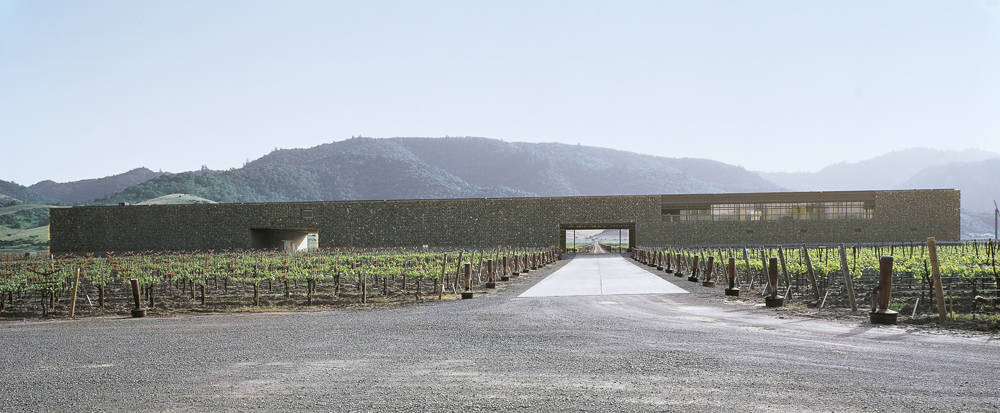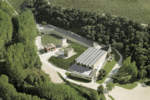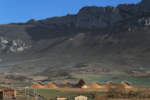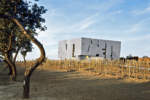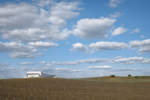Herzog & De Meuron, Dominus Winery 1996-1998 - photo by Margherita Spiluttini
On an international level the places where wine is made have the befitting name of “wineries”. In Italy, vice versa, the term used is “cantine” or cellars; in France they go by the lofty name of “castle”. The difference in terminology is anything but banal from an architectural view; it reveals the typological metamorphoses which have changed the traditional place of production – at least in the two countries in the world that compete for the leadership as wine producers – from buildings (or parts of them) that also serve other purposes, to the contemporary industrial sites specifically designed for the processing of a product that is inseparably linked to farming production, namely vineyard cultivation. These brief considerations, even if expressed in simplified terms imposed by the need for synthesis due to an apparent dictionary-based dispute, can actually help us to understand the dynamics that have by now for at least two decades characterized a very important economic activity which has wielded a direct influence on the industrial architecture and landscape, on vast parts of the territory and thus on the natural landscape, on the uses and costumes of many communities where habits and behaviours change, as is only natural, as the basic socioeconomic conditions change. To proceed in the right order it is necessary to once more underscore that, in terms of building typologies, “wineries” are relatively young industrial and at the same time commercial aggregates. The places where wine was made were originally part of the mansions of the nobility or landowners who dedicated large areas in the basements of their villas or castles to the fermentation of grapes which were then stored in containers, wooden caskets or directly in glass bottles, depending on the type of production, for subsequent aging. The interment and systematic occupation of the underground rooms of such prestigious and important residential complexes was due to the climatic conditions necessary to make wine. In fact, when it is aging wine must “rest” in spaces where the temperatures are low and constant both in summer and winter.
These areas must also be damp, to reduce the evaporation of the product. It is obvious that in the past these conditions were found naturally (as energy and systems for the mechanic control of the temperature did not exist) only by exploiting the thermal inertia of the ground, its intrinsic humidity content and the coolness of spaces placed far away from the heat of the sun. These places dedicated to making wine are almost always concealed from sight, protected in the underground foundations and storage areas, covered by gardens and lawns; this has given rise to the Italian toponym “cellars”, spaces that blend perfectly into the architecture and the landscape. We may in this phase speak of production places conceived as parts of buildings; the cellar as “casket”.
It is moreover important to remember that what is by now a prestigious beverage linked to the pleasure of drinking and restaurant activities of a certain level, was once an essential part of the diet of the poorest social classes, that then consisted of poor and simple ingredients as “bread and wine” that provided the carbohydrates and sugars necessary to offset the waste of energy caused by the work in the fields. This is why, especially in Italy, not only the noble residences but all the farmhouses had small areas in their cellars for a very simple production that represented, as opposed to today, a very dense and extensive production network made of micro-units scattered in the territory, which had no relation to the present-day industrial production and commercial dimension. With the progressive abandonment of the countryside and the transformation of agriculture from a cottage industry to an industrial activity, in the phase that took place in the years after World War II, the wine production has generally been concentrated in banal buildings with artificial air conditioning, thanks to a widespread availability of electrical energy and a relatively easy transport of goods and products. The farmers brought their grape harvest to these places, where they were processed in an anonymous and indifferent manner; what mattered was not the label understood as particular and specific production, but rather the geographical area of provenance indicated as the zone in which a certain type of wine was produced. As a result, the building in which the wine was actually made, stored and aged did not play any important role in terms of architecture or landscape design, as it merely served a practical role. These were the years, at least in Italy, of the development of the so-called “social wineries”. We may define this relatively recent and brief phase as a period of transition and transformation of the old cottage industry into industrial units characterized by a need to replace the previously diffused micro-production in bigger buildings conceived and built to meet, as economically as possible, the productive requirements in simple containers; the winery as “box”. The further and rapid improvement of the living standards and the consequent new daily habits linked to a more frequent enjoyment of meals outside the home, has quickly transformed the way to consume wine, with the creation of a demand aimed at identifying, through a distinction of the vineyards, the production and provenance of the grapes, particular characteristics studied to meet a parallel diversification of the offer of foods, created by an ever greater appreciation of the art of cooking. The new role played by wine within the food chain has reduced the pro capital consumption to a degree that is inversely proportionate to the increase of the cost of production, that is the direct consequence of a continuous demand for specialization and productive sophistication. Wine, the relative knowledge and culture, and in the final analysis the pleasure and awareness of drinking, have rapidly become elements of social and intellectual distinction; a way to establish one’s identity in the satisfaction of daily activities as eating, revealing a lifestyle that turns necessity into opportunity, need into desire. Parallel to “dressing” which is changing on an international level from an everyday obligation to a symbol of the degree of well-being or social position, “drinking” becomes a fashion phenomenon, a global need to demonstrate one’s taste, one’s ability to choose and awareness of one’s lifestyle, a way to assert that it is possible to attain pleasures and habits that used to be reserved for a very small elite. Taste, the ability of a product to keep it constant over time, its differences and variations according to season, year of harvest, grapes and area of production become variables that determine the success of one product rather than another, opening an ineluctable global competition which spreads beyond Europe (above all Italy and France) to California, to South America and in particular Chile and Argentina, to South Africa, to Australia, finally reaching even China with its extraordinary agricultural and industrial potential and its great rapidity in adapting to and meeting the demands of a population characterized by an impetuous socioeconomic development. The research for quality and distinction, for the peculiarities of a certain product, runs like a red thread through the whole production chain, characterizing and qualifying the production towards the higher brackets; from the initial conditions which are the earth and the places of production, to the raw materials, the vines and the grapes, to the areas where the actual transformation takes place and finally to the buildings where the wine is made and the way in which it is made, the naturalness and simplicity with which the desired results are achieved. Lacking a true tradition, a history, castles, lordly palaces or old mansions, the Americans are capable, like no-one else on the planet, to plan, program and build myths, to “create” agricultural areas specifically dedicated to wine from scratch, as for instance Napa Valley in California, in such a manner as to rival and emulate historicized and universally famous areas as Bordeaux in France or Chianti in Italy. At the same time they apply their consolidated expertise in production and commerce, inventing fascinating places for the processing of the grapes and the production of the wine; while these places cannot compete in terms of history, they can on the contrary outdo ancient European wineries on a level of services and size, as they are designed from scratch to meet the demands of a new public, a new clientele and a new market. With a pragmatism we must recognize that the Americans possess, they have been among the first to pose the problem of the success and commercial fortune of their products; a success which, in the case of a particular beverage like wine, above all depends on its intrinsic quality, which is the result of a careful research that has a cost and a price that must be justified and explained, even exalted.
The Americans have advanced the idea that so complex, long and in the final analysis costly enological processes must perforce be shown to the public and to the potential consumers, in an as efficient and convincing way as possible. To visit wineries is therefore not an ephemeral, temporary fashion, but a specific requirement of a market where the value and the surplus value must be based on objectively verifiable data, such as the adequacy and beauty of the landscapes and areas of production, the attention dedicated to the work, the quality of the materials and places used for the production process, the time and duration of this process, its naturalness, the rarity and in the final analysis exclusiveness of what one is buying, sometimes at a very high price.
The challenge today is to create wineries that are not only industrial places, adequate to produce wine, but also fascinating and charming spaces that blend perfectly with the landscapes in such a way that they do not alter the natural beauty of the areas where the vineyards are located, but are practical and efficient in order to assure the economic viability and practically of the production and transport of the end product. Buildings that are sufficiently large to house the areas for aging the whole production in caskets, but at the same time feature environments that are not anonymous and indistinct, as this would thwart the pursuit of an intrinsic mystical and exclusive character of the product, which is on the contrary consolidated by the ancient castles and old mansions that distinguish the most famous and appreciated wine tradition. The sought-for and indispensable naturalness of the production and the utilization of traditional techniques and methods make it necessary for the buildings to bury their roots in the ground, and to find their own “temperature” and “humidity” in a sustainable manner without the use of sophisticated air conditioning systems, relying, as in the past, on the energy obtained directly from the ground. The exploitation of the natural slopes of the land whenever possible makes it possible to avoid the use of mechanical systems and pumping when handling the grapes, the must and the wine, as far as possible relying on the dynamic of fluids by taking advantage of gravity.
While the latter conditions, imposed by the need to assure a sustainable production process, is an essential part of the tradition and the oldest wineries, it is equally true that the latter find it difficult, and are unsuited, to tackle present-day industrial dynamics, as well as to meet the commercial requirements associated with the need to allow visitors to observe every place and phase of the production. This is why even the most famous and consolidated wineries have adapted themselves to the need to meet the new demands of a market that has by now become global. Analogously, contemporary wineries have become the stage of the most exclusive design research, to which almost all the leading figures of the contemporary architectural debate have contributed. Sometimes we find a research carried to extremes, aimed at making an amazing and singular impact, and some project clearly reveal an excessive desire for monumentality, while others exaggerate in scenic effects in an attempt to appeal to the memories and associations of the visitor, but the wide range of designs all respond to the need to define a new building model capable of giving a concrete expression to requirements that sometimes conflict with the needs of such a particular and specialized productive activity.
Partly factory, partly church or holy place – we must not forget that in Western symbology wine is the simulacrum of the blood of Christ – partly rural village or country house, partly castle or lordly mansion, the places where wine is produced today are actually “parts of the landscape”, fragments of a territory where art and culture, innovation and tradition, agriculture and industry, are merged and confused in an aggregate that has to balance different and variegated aspects. Many contemporary projects clearly show, highlight or more simply prioritize one of the aspects stressed here, but it is in the difficult and equilibrated relationship with the surrounding environment that the building where wine is produced demonstrates its sagacity and value, because its richness and fortune, now as in the past, comes directly from the earth.


